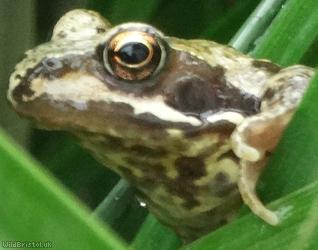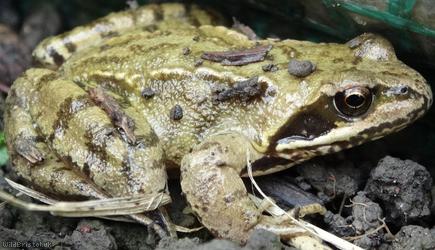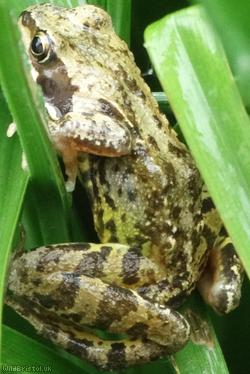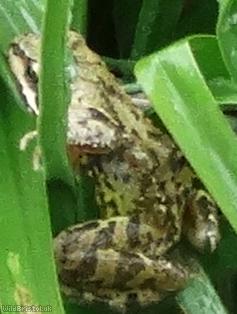Common Frog - Rana temporaria
Favourite Photos
Species Description
Common and widespread throughout. Habitats include: Any where nearby to a fresh water source such as ponds in gardens, parks, allotments, cemeteries, farmland, wetlands, lakes, slow-moving rivers/streams, woodland, hedgerows etc. Lifespan: in the wild usually 2 to 10 years, with an average of 5 - 7. However in gardens or captivity they commonly reach into their teens or even 20's and some can even reach into their late 30s! There is a record of the closely related Common Toad (captive) having lived to the age of 42! Life story: Common Frogs are ready to breed from the age of 2 - 3.
Description and measurements:
Size: Length = usually between 8 and 13 cm when legs are folded up but occasionally 'monsters' occur. Males are smaller. They can range from olive-green and brown to Red, Pink, Yellow, Lime Green or Black. An individuals skin colour changes throughout the year depending on how wet they are and what their surroundings are like. Frogs skin is super absorbant meaning they essentially take on the pattern of their surroundings. Usually they are lighter in the summer, turning more olive in colour and after emerging from brumation during the winter are usually more dark colours from grey to brown. Every individual has a unique pattern on their skin.
Frogs brumate (hibernate - a term specific to Amphibians) during the winter months from about Late October to February or March.
Breeding usually occurs in March. But it depends on region and local populations. In the North its usually later than in the South. It ranges from as early (or late if you like) as December in the South West to as late as May in Scotland.
Common Frogs go through a period of brumation during the winter months. Some brumate (usually Males) at the bottom of a pond in the muddy/silty layer and others on land in old animal burrows or piles of leaves and logs or a compost bin - anywhere to avoid frost.
How to tell the difference between Male and Female:
This is easiest to do during the breeding season when they are most sexually dimorphic (Females are larger than males and usually lighter coloured - light brown olive colour; whereas Males are usually grey. Females have longer more slender arms in proportion and have more slender and longer fingers, and their upper arms are significantly thinner compared to their forearms whereas in Males they are more muscular, stumpy and bulkier from the shoulder. And they have shorter more muscular fingers which have sticky pads to grip onto Females, Females heads are usually fatter and more rounded than Males which are slightly more triangular).
Frog defences against predators:
They can release urine which has an unpleasant smell to get the predator to drop it, Very powerful legs that can propel them very far and they can jump fast and switch directions quickly they are even more of the latter when in their fight or flight response, Their triangular shaped head and sliminess and squash-ability allow them to easily escape through relatively small gaps, finally they can scream really loudly (sounds like a loud human child).
Other names include: European Common Frog, European Common Brown Frog, European Grass frog, Grass Frog.
Females lay up to 3000 eggs at a time and can lay up to about 3 times (first time Females lay less and usually only one clusture). When they are first layed they are small (like a clusture of caviar) an they quickly swell as they absorb the water around them to up to the size of a football. Each egg reaches about 1 cm in diameter at this stage. As the tadpoles develop from a circle to peanut shape then to oblong peanut then curled up tadpole they hatch after about 2 to 3 weeks looking like small tadpoles with gills they feed on the shells of their spawn and algae. After another 2 weeks they lose their external gills and start to develop gold speckles and continue to grow. After another 3 to 4 weeks they develop stumps where their legs grow and soon turn carnivorous eating insects which land on the surface and even each other. When they reach leg stage they lose their gills and have to breath through their mouth at the surface until their skin grows to breath under water they also release a chemical which prohibits other tadpoles from developing and stunting their growth. They also may turn on each other and start biting bits out of the side of their heads. It's all about competition for the most food. The more space there is per tadpole the more food there is. After about 8 weeks their legs continue to grow and their arms start to appear as stumps. After another 3 weeks they have fully developed arms and legs and their body and tail begin to shrink as they become more frog like. Once the Tadpole has completely metamorphosised into a froglet (baby frog) they leave the water but must stay damp. They hunt small flies and other invertebrates. Hunting for larger prey as they grow. They won't return to breed for another 2 to 3 years. Tadpoles sometimes overwinter if there's not enough food and then turn into a froglet the next spring.
Per a thousand eggs only between 5 and 10 will make it to adult hood to breed. Most will either get eaten by predators, won't survive the winter, or other causes such as getting run over.
Because Females are bigger they tend to travel further afield for food and so brumate further away from where they were born.
Generally males hibernate (or brumate - term specific to amphibians) at the bottom of ponds and females on land under logs, leaf piles, compost bins etc. which is why males are normally first to be seen and females arrive later. It's also why females tend to be lighter coloured than males in the spring. It still isn't fully understood why but frogs skin is very absorbant. Infact they drink and breath (when under water) through their skin. It's likely that they 'absorb their surroundings' through minute water soluable particulates which is why an individual varies so much in colour throughout the year. During mild spells particularly after cold snaps they may come out to hunt and males may surface to see if it's spring yet. In the South-West spawning can be as early as December to as late as April but generally occurs in February and March.





